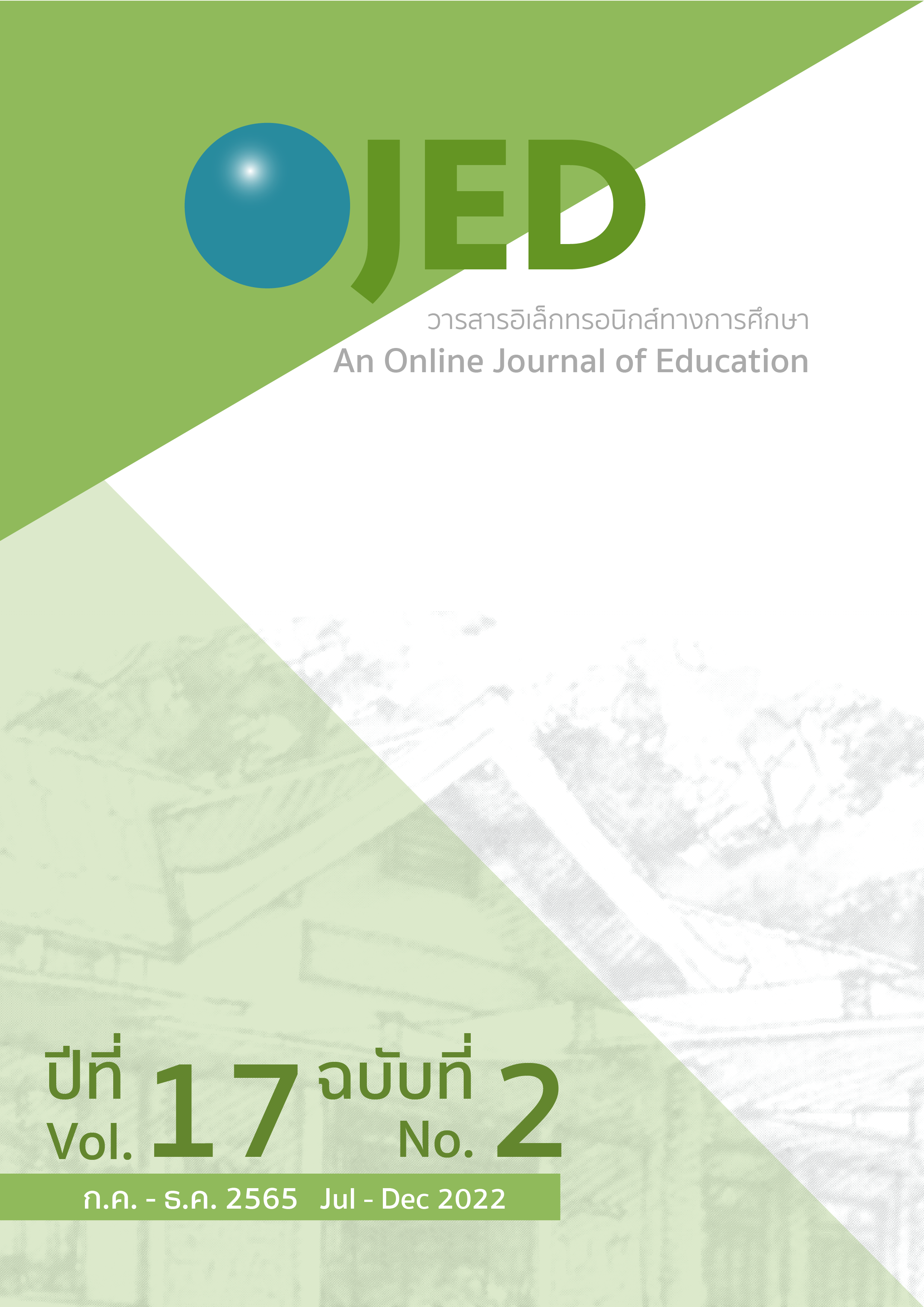Parents’ Roles in Promoting Loose Parts Play in the Loose Parts Kits Project
DOI:
https://doi.org/10.14456/ojed.2022.51Keywords:
parent roles, Loose parts play, preschoolAbstract
The purpose of this research was to study parents’ roles in promoting loose parts play in the loose parts kits project for 3 aspects comprised of observation, facilitating children’s play, and preparing a play environment. The population used in the study was parents of 55 children from the age of 3 to 5 in the academic year 2021. A questionnaire was developed in a Google form. The data were analyzed by using frequency distribution, percentage, mean, standard deviation, and content analysis. The research findings were that the overall role of parents in promoting loose parts play was at a high level (M = 3.68, SD = 0.58). Considerably, all aspects were at a high level for parents’ roles (3.90 ≤ M ≤ 4.43). They were (1) observation (M = 4.43, SD = 0.43), which consisted of emotion (M = 4.45, SD = 0.44) and playing behavior (M = 4.41, SD = 0.49); (2) facilitating children’s play (M = 4.04, SD = 0.54), which consisted of establishing a play agreement (M = 4.15, SD = 0.56) and guided play (M = 3.93, SD = 0.65); and (3) preparing a play environment (M = 3.90, SD = 0.61), which consisted of organizing the play area (M = 4.04, SD = 0.69) and the preparation of loose part materials and accessories (M = 3.76, SD = 0.83), respectively.
References
Better Kids Care. (2019). Loose parts: What does this mean?. PennState Extension. Canadian Public Health Association. (2019). Loose parts play policy. http://www.cpha.ca/sites.default/files/upload/resources/play/loose-parts-e.pdf
Casey, T., & Robertson, J. (2016). Loose Parts Play. https://creativestarlearning.co.uk/wp-content/uploads/2020/05/Loose-Parts-Toolkit.pdf
Casey, T. & Robertson, J. (2017). Resources for playing – providing loose parts to support children’s play A toolkit. www.playwales.org.uk/eng/
Casey, T., & Robertson, J. (2019). Loose parts play: A toolkit (2nd ed.). Inspiring Scotland.
Cawley, J. (2019, 29 July). The role of the adult in loose parts play. https://playoutsidens.com/2019/07/29/the-role-of-the-adult-in-loose-parts-play/
Committee on the Rights of the Child. (2013, 18 March). General comment No.18 (2013) on the right of the child to rest, leisure, play, recreational activities, cultural life and the art (art.31). CRC/C/GC/17. https://archive.crin.org/docs/CRC-C-GC-17_en.
Daly, L. & Beloglovsky, M. (2015, June 2). Loose parts: Inspiring play in young children. community playthings. https://www.communityplaythings.com/resources/ articles/2015/loose-parts
Drake, J. (2014). Planning for children’s play and learning. Routledge.
Gull, C., Bogunovich, J, Goldstein, S. L., & Rosengarten, T. (2019). Definitions of loose parts in early childhood outdoor classrooms: A scoping review. The International Journal of Early Childhood Environmental Education, 6(3), 37-52.
Mendizza, M., & Pearce, J. (2002). Magical parent magical child. In-Joy Publications.
Myers, R. (2019). The well-balanced family: Reduce screen time and increase family fun, fitness and connectedness Book Baby.
Pearce, J. C., & Mendizza, M. (2003). Magical parent - magical child, the optimum learning relationship. In-Joy.
Spencer, R. A., Joshi, N., Branje, K., Rehman, L., Kirk S. & Stone M. (2019). Educator perceptions on the benefits and challenges of loose parts play in the outdoor environments of childcare centres. AIMS Public Health, 6(4), 461-476.
Tremblay, M. S., Gray, C., Babcock, S., Barnes, J., Bradstreet, C. C., Carr, D., Chabot, G., Choquette, L., Chorney, D., Collyer, C., Herrington, S., Janson, K., Janssen, I., Larouche, R., Pickett, W., Power, M., Sandseter, E. B. H., Simon, B., & Brussoni, M. (2015). Position statement on active outdoor play. International Journal of Environmental Research and Public Health, 12(6), 6475–6505. https://doi.org/10.3390/ijerph120606475
Wahyuni, S., & Reswita, R. (2020). Pemahaman Guru mengenai Pendidikan Sosial Finansial pada Anak Usia Dini menggunakan Media Loose Parts. Journal Obsesi: Journal Pendidikan Anak Usia Dini, 4(2), 962. https://doi.org/10.31004/obsesi.v4i2.493
Ward, K. (2018). What’s in a dream? Natural elements, risk and loose parts in children’s dream playspace drawings. Australasian Journal of Early Childhood, 43(1), 34-42. https://doi.org/10.23965/AJEC.43.1.04
Downloads
Published
How to Cite
Issue
Section
License
Copyright (c) 2022 An Online Journal of Education

This work is licensed under a Creative Commons Attribution-NonCommercial-NoDerivatives 4.0 International License.




